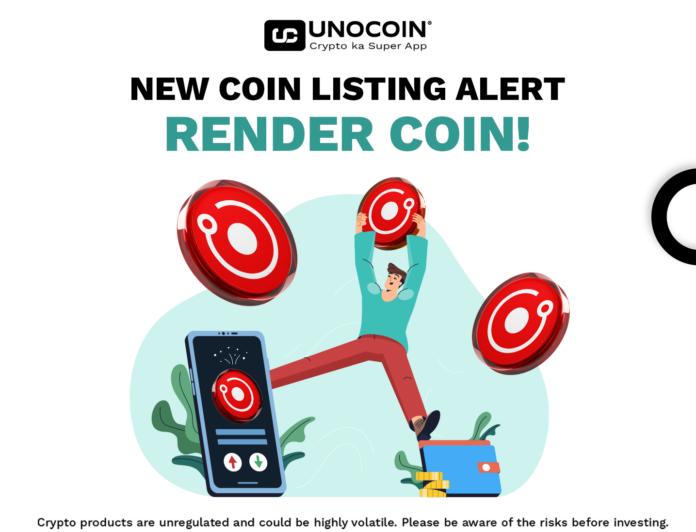Unveiling the transformative power of the render mesh in the 3D rendering revolution
In the ever-evolving landscape of digital entertainment, 3D rendering plays a key role in shaping immersive experiences, from animated films and online gaming to the growing crypto metaversion. Demand for high-resolution user experiences has skyrocketed, intensifying the need for efficient and scalable 3D rendering solutions. Render Network, with its innovative approach and decentralized infrastructure, is a catalyst for a revolution in the way GPU rendering is used and offers a glimpse into the future of digital content creation. This article explores the complexities of the Render Network, from its core technology to its Proof-of-Render governance system and the dynamics of its native utility token, RNDR.
3D rendering powers the Crypto Metaverse
In the vast field of digital entertainment, including animated films, online gaming and the emerging crypto metaversion, 3D rendering is a mainstay. Its applications extend beyond entertainment to industrial areas such as product prototyping, simulation, scientific visualization and architectural design. At the heart of this technological marvel is the 3D rendering process, where a GPU device transforms a 3D model into a visually detailed display that involves complex algorithmic calculations. As the demand for immersive digital experiences grows, the complexity of the computations required to bring these virtual worlds to life intensifies.
The essence of 3D rendering is enhanced when real-time graphics creation is involved, as seen in digital games and virtual reality (VR) environments. This dynamic landscape presents unique challenges, demanding solutions that can accommodate the complex computations necessary to create these immersive digital realms.
What is RNDR? Crypto for On-Demand GPU Rendering
Enter Render, a pioneering platform designed to harness the untapped power of users’ GPU resources to render motion graphics and visual effects. In return for contributing their unused GPU performance, users receive render tokens (RNDR), the native utility token of the render network. Render introduces a peer-to-peer (P2P) network, creating an ecosystem where individuals can efficiently utilize unused computing power, disrupting the traditional paradigms of rendering and streaming 3D environments.
Render Network solves three fundamental problems for its users:
Scalability: The strength of Render lies in its scalable GPU rendering network, which can scale to any size to meet user requirements. The decentralized network uses an automated reputation and job allocation system that offers an efficient alternative to localized market solutions.
Optional: Users on the Render Network can enjoy greater operational efficiency and flexibility in service selection. Whether it’s placing an order or using excess GPU power, the platform will satisfy a spectrum of user needs. This flexibility is particularly beneficial for motion graphics and businesses that rely heavily on 3D rendering, alleviating concerns about the significant upfront investment and high operational costs associated with maintaining GPU-intensive data centers.
IP Protection: Render prioritizes effective digital governance, including record-keeping and blockchain-enabled encryption. Unlike centralized platforms prone to censorship or deletion of user data, Render leverages the immutability of the blockchain to ensure creator rights are protected throughout the creative lifecycle.
Render Network’s Proof-of-Render (PoR) management system
Render Network’s core architecture is built on the Ethereum blockchain and uses OctaneRender, developed by OTOY, the graphics software company behind Render Network. Ethereum integration facilitates data authentication and payment processes, while OctaneRender, coupled with the open-source ORBX media and streaming framework, increases rendering efficiency.
Render uses a Multi-Tier Pricing Protocol (MTP) that uses user reputation scores to allocate tasks and maintain a high quality of service. Users, referred to as creators, can choose from three tiers: Tier 1 (Trusted Partners), Tier 2 (Priority), and Tier 3 (Economic). The tier system introduces a dynamic where higher-level services require a premium fee and are typically provided by reputable GPU rendering service providers known as node operators. A creator’s reputation score, influenced by node operator feedback, determines the speed at which requested tasks are completed.
This tiered configuration serves as the foundation for Render Network’s Proof-of-Render (PoR) management system. Similar to Proof-of-Work (PoW), PoR requires node operators to spend computing resources not on solving mathematical puzzles, but on completing complex VFX/3D rendering services. Render’s pricing algorithms update autonomously based on GPU performance, cloud rendering costs, electricity costs, and network supply and demand patterns.
Each user on the Render Network has a unique identifier associated with their OctaneRender account, in compliance with Know-Your-Customer (KYC) requirements to prevent fraud and duplicate accounts. The rendering progress of the node operators is monitored in real-time by the creators through OctaneRender, allowing abnormalities to be identified before the job is complete. In addition, the Render Network uses automated ratings, penalizing inefficient node operators and redirecting jobs if there are significant differences between the node operator’s computational potential and actual output quality.
How to use Render Network
The Render Network acts as an automated marketplace, providing a seamless process for content creators (Creators) to upload GPU-based rendering jobs to be completed by Render’s decentralized network of GPU Service Providers (Node Operators). A user’s journey to Render Network includes the following steps:
Job Creation: Creators submit their jobs in ORBX file format using OctaneRender or supported plugins/integrations. Key parameters such as graphics resolution, output format and sample size are defined. Creators can also choose a service level based on priority levels and on-chain node operator performance tests and reputation scores.
Job Upload: The job is uploaded via Render’s OctaneRender web portal. Creator assets are encrypted, hashed and separated into individual files, ensuring traceability and preventing malicious behavior. Job requests and payment terms are sent to a smart contract that broadcasts the relevant details throughout the Render network.
Task Assignment: The Render MTP protocol automatically assigns node operators to appropriate tasks based on reputation scores and renderer specifications. Once connected to the network, Render evaluates the performance capabilities of the node operator and incorporates this information
Please find the list of authentic Unocoin accounts for all your queries below:
- YouTube Channel: https://www.youtube.com/c/Unocoin/videos
- Newsletter: https://medium.com/subscribe/@Unocoin_growth
- Blogs: https://blog.unocoin.com
- Instagram: https://www.instagram.com/unocoin/
- Twitter: https://twitter.com/Unocoin
- Facebook: https://www.facebook.com/unocoin/
- LinkedIn: https://in.linkedin.com/company/unocoin
- Telegram Group: https://t.me/Unocoin_Group
- Telegram Channel: https://t.me/+fasQhTKBsfA5N2Zl
- Telegram: https://t.me/UnocoinSupport_Bot
- E-mail id: [email protected]
- Contact details: 7788978910 (09:30 AM IST – 06:30 PM, Mon – Sat)
- App store link: https://apps.apple.com/us/app/unocoin/id1030422972?ls=1
- Playstore link: https://play.google.com/store/apps/details?id=com.unocoin.unocoinwallet
Disclaimer: Crypto products are unregulated as of this date in India. They could be highly volatile. At Unocoin, we understand that there is a need to protect consumer interests as this form of trading and investment has risks that consumers may not be aware of. To ensure that consumers who deal in crypto products are not misled, they are advised to DYOR (Do Your Own Research).




![Fundamental Analysis in Crypto [Updated Guide] A Comprehensive Guide to Asset Valuation.png](https://blog.unocoin.com/wp-content/uploads/2024/11/A-Comprehensive-Guide-to-Asset-Valuation-218x150.png)